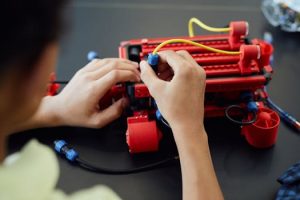Overcoming Challenges in Hybrid Education
As the world continues to adapt to the new normal caused by the COVID-19 pandemic, education has also undergone a massive change. Traditional in-person learning has taken a backseat, and hybrid education has emerged as the go-to option for educational institutions. Hybrid education combines both in-person and online learning, allowing students to have a balance between virtual and physical classrooms. While hybrid education offers many benefits, it also comes with its fair share of challenges. In this article, we’ll explore the various challenges of hybrid education and how to overcome them.
1. Limited Face-to-Face Interaction
One of the most significant challenges of hybrid education is the limited face-to-face interaction. In traditional in-person learning, teachers and students have direct and continuous interaction, which helps build a connection and understanding between them. However, with hybrid education, physical interaction is limited, and students may miss out on the personal touch and guidance that teachers provide in the classroom.
To overcome this challenge, teachers must make an extra effort to connect with their students, even in the virtual setting. This can be done through regular check-ins, one-on-one consultations, and virtual office hours. Teachers can also encourage students to interact with their peers through group activities and discussions, which can help foster a sense of community and collaboration.
2. Technical Difficulties
Another significant challenge of hybrid education is technical difficulties. While online learning platforms have become more advanced, technical issues such as poor internet connection, software glitches, or hardware malfunctions can disrupt the learning process. These technical difficulties can be frustrating and can lead to a loss of valuable learning time.
To overcome technical difficulties, students must have access to reliable technology and a stable internet connection. Teachers can also provide students with resources and troubleshooting tips for common technical problems. In addition, educational institutions can invest in IT support and training for teachers and students to minimize technical issues.
3. Maintaining Student Engagement
One of the biggest challenges for teachers in hybrid education is maintaining student engagement. In a virtual setting, students may become easily distracted, leading to a lack of participation and interest in the lesson. This can hinder the effectiveness of learning and result in a disengaged and disinterested class.
To overcome this challenge, teachers must employ various teaching strategies and techniques to keep their students engaged. This can include interactive and hands-on activities, using multimedia tools, and incorporating real-life examples to make the lessons more relatable and interesting. Teachers can also provide regular feedback and recognition to keep students motivated and interested in the learning process.
4. Balancing Workload
With hybrid education, students are expected to balance their workload between virtual and in-person learning. This can be overwhelming, especially for students who are used to the structure of traditional in-person learning. Students may struggle to manage their time and prioritize their tasks, leading to academic stress and a decline in performance.
To overcome this challenge, teachers must communicate expectations clearly and provide students with a structured schedule. Educational institutions can also offer time-management workshops and resources to help students manage their workload effectively. Students must also practice good time-management techniques, such as setting aside dedicated study time and creating a to-do list to keep track of their assignments and responsibilities.
5. Adapting to Different Learning Styles
One of the key advantages of hybrid education is its flexibility, allowing students to learn in their own way and at their own pace. However, this also poses a challenge for teachers as they must cater to different learning styles and ensure that all students are learning effectively.
To overcome this challenge, teachers must use a variety of teaching methods that cater to different learning styles. This can include visual aids for visual learners, hands-on activities for kinesthetic learners, and in-class discussions for auditory learners. Teachers must also provide students with alternative resources and materials to accommodate their individual learning needs.
Conclusion
Hybrid education has quickly become the new normal in the education sector, and while it offers many benefits, it also comes with its challenges. However, by acknowledging and addressing these challenges, educational institutions and teachers can ensure a successful hybrid education experience for their students. With proper communication, support, and adaptation, we can overcome the challenges of hybrid education and provide a quality learning experience for students.







